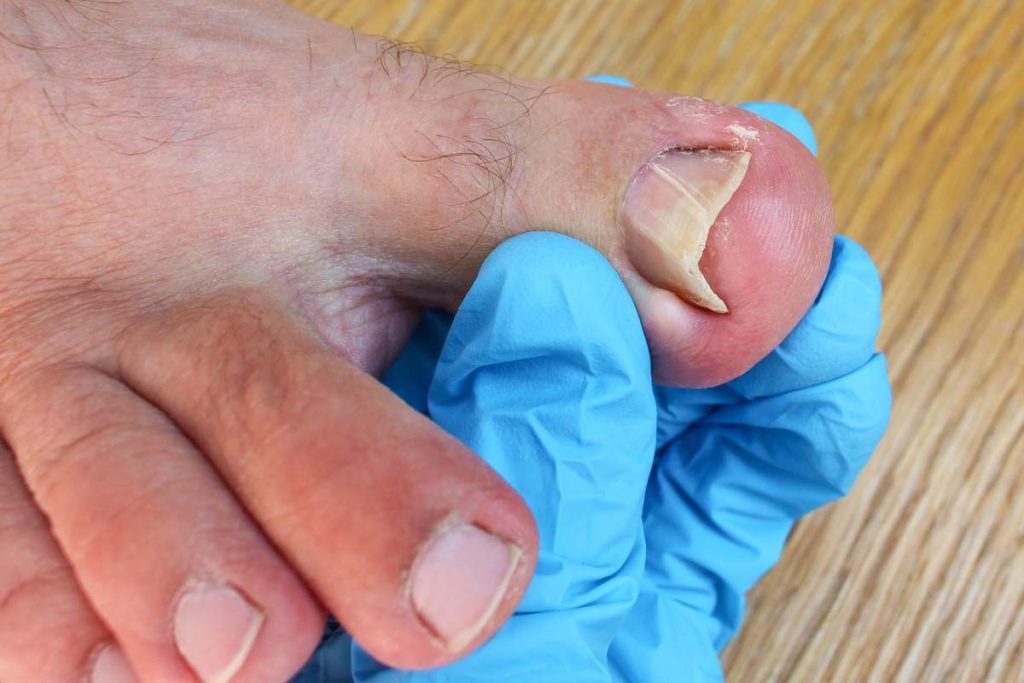Getting rid of an ingrown toenail can be painful and frustrating. Here at Foot + Ankle Specialty Centers, we understand the pain and hassle it brings. We provide effective and compassionate care to help you get back on your feet pain-free. So, stop searching for “ingrown toenails Treatment Phoenix” and let’s see the treatment options and how to fix it.
What is an Ingrown Toenail?
This condition happens when your toenail edge grows into the surrounding skin. This unnatural growth often leads to pain, swelling, and sometimes infection. This condition affects people of all ages. Remember. Ingrown toenail in Phoenix can be particularly troublesome if left untreated.
What are Ingrown Toenail Treatments in Phoenix?
Here’s our step-by-step process of ingrown toenails treatment Phoenix:
- We begin by thoroughly examining the affected to assess the severity of your condition and check for any infection symptoms.
- We carefully clean and disinfect the surrounding area of your toenail to reduce the risk of infection or nail fungus in Arizona and prepare the site for treatment.
- Using our specialized tools, we gently lift the ingrown part of the nail. If necessary, we may use special clippers to trim or remove the ingrown portion to alleviate pressure and pain.
- We apply a medicated dressing to the treated area to soothe the skin, reduce pain, and prevent infection. This dressing also promotes healing and helps keep the area clean.

Why Choose Our Ingrown Toenail Treatments?
Our ingrown toenails treatment Phoenix is fast, gentle, and done right in the office. We numb the area, take care of the problem, and help keep it from coming back. You’ll walk out feeling way better than when you walked in.
Our team has seen every kind of ingrown toenail. We don’t judge. We just fix it. Whether it’s your first one or your fifth, we’ll help you heal fast. People trust us for ingrown toenails treatment Phoenix because we make it easy, clean, and as pain-free as possible.
What Causes Ingrown Toenails?
- Improper nail trimming
- Tight-fitting shoes
- Toe injuries
- Genetic predisposition
- Poor foot hygiene
Ingrown Toenail Symptoms
Signs include:
- Pain along the side of the toenail
- Redness and swelling
- Infection signs like pus
- Difficulty walking due to pain

Ingrown Toenail Treatment Near Me in Phoenix, Arizona
Stop searching for “ingrown toenails treatment Phoenix“; you’ve found the place. If you’re struggling with this condition, don’t wait for it to worsen. Visit Foot + Ankle Specialty Centers for expert care and relief. With branches in Gilbert, Scottsdale, Chandler, Mesa, and Phoenix, Arizona, we are ready to help you. Stop Googling “ingrown toenail removal near me” and Contact us today to schedule an appointment and take the first step toward pain-free feet.
FAQs About Ingrown Toenail Treatment in Phoenix
Are ingrown toenails permanent?
No, with proper treatment, they can be resolved effectively.
When should I see a doctor for an ingrown toenail?
If your toe is red, swollen, or hurts to walk, it’s time for ingrown toenails treatment.
How to Remove an Ingrown Toenail Yourself?
We don’t strongly recommend this treatment at home. Impractical kits and careless removal at home can lead to complications. It’s best to visit one of our 5 clinics.
What Does an Ingrown Toenail Look Like?
If you look at ingrown toenail pictures, you can see redness and swelling around the affected area.
Can I fix an ingrown toenail at home?
Mild cases might improve with warm soaks and gentle care. But if it’s infected or keeps coming back, see a podiatrist in Arizona right away.
How Can You Tell If You Have Ingrown Toenail?
If you feel persistent pain and see redness and swelling around your toenail, especially if it’s getting worse, you likely have this condition.
Will an Ingrown Toenail Eventually Grow out?
Yes, it might eventually grow out on its own, but you often need our proper care and attention.
Do kids and teens get ingrown toenails too?
Yes, especially from tight shoes or sports. We treat young and adult patients in Phoenix every day to keep toes pain-free.
Related Blogs

Why Your Ingrown Toenails Keep Coming Back + Treatment
When your ingrown toenail keeps coming back, it’s more than a small foot problem. It’s painful, annoying, and often disrupts simple things like walking, working, or

Why Does My Toe Still Hurt After Removing Ingrown Toenail?
Having an ingrown toenail removed is supposed to bring relief, right? But sometimes, you see your toe hurts after removing ingrown toenail. It’s frustrating when you’ve


